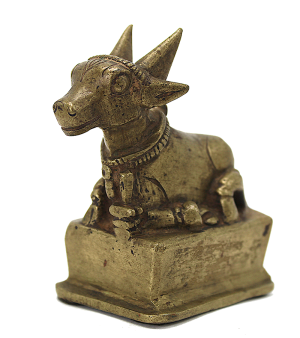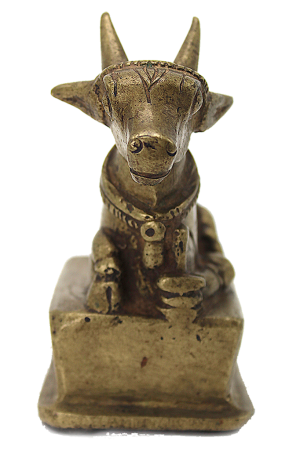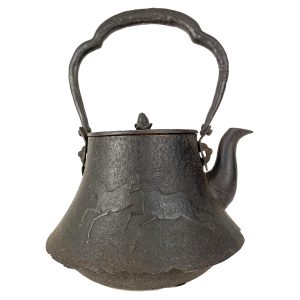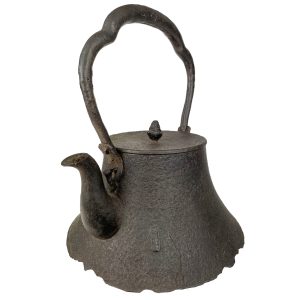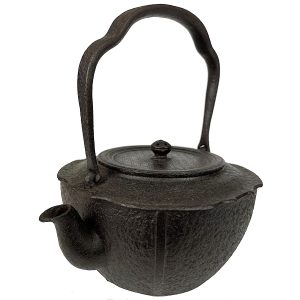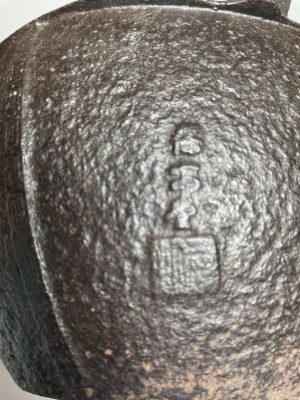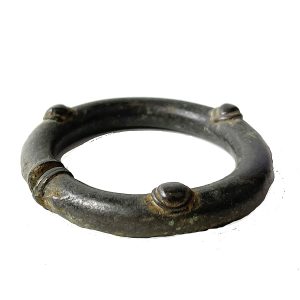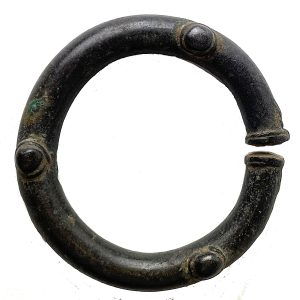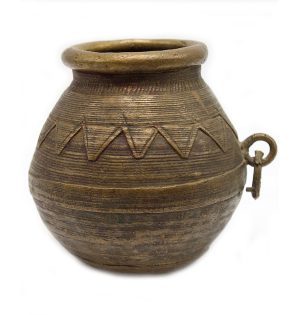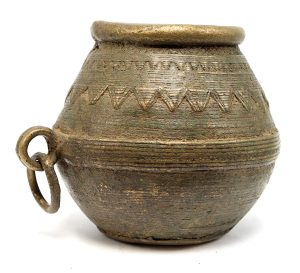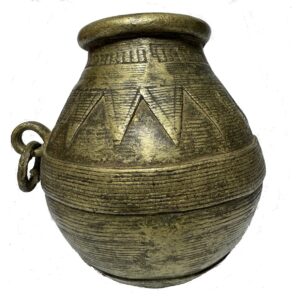Showing 1–12 of 36 results
-
Sale!


$295.00 Original price was: $295.00.$195.00Current price is: $195.00.
H: 3.125″ W: 3.125″ D: 0.75″ | FREE SHIPPING!
This horseshoe-shaped manilla from the Mali and Niger region is decorated with hammered and incised embellishments, designs, and decorative motifs unique to individual Tuareg tribes that have been passed on for generations. It is divided into distinct sections, each with detailed traditional etched linear designs, circular cutouts, diamonds, grooves and terminating in large rounded knot finials incised with layered triangles designs. Bracelets/anklets of this massive size were never worn as jewelry but were used as currency and to represent status. The patina shows its age, long use, and wear. It comes with a wood and metal stand.
-


$155.00
Nandi is among the most frequent Hindu deities worshiped in public places, temples, homes, or on a home altar throughout India. As one of Hinduism’s mythical animals, Nandi is Shiva’s vahana, (his mount that transports him), attendant and leader of his attendants and guardian of all four-footed animals. A recumbent image of Nandi on a…
-


$425.00
A stupa is a memorial shrine and a sacred burial mound to house sacred relics associated with the Buddha or other Buddhist saintly persons, a symbol of the Buddha’s enlightenment and a model of the Buddhist cosmos (McArthur, p. 179). Initially they were hemispherical mound-like shapes and were transformed in East Asia into a pagoda…
-
Sale!


$695.00 Original price was: $695.00.$550.00Current price is: $550.00.
Ht: 12.5″ W: 10″ D: 9.5″ | CALL 213-568-3030 OR EMAIL [email protected] FOR SHIPPING COST
Made in the Meiji era (1868-1912),this hand crafted antique Japanese cast iron tetsubin teapot has an unusual decorative handle and curved spout and has a beautiful relief design of galloping horses. Horses have been revered creatures in Japanese culture that embody grace, power and nobility. The knob on the lid probably represents a lotus, the Buddhist symbol of purity and enlightenment. As with all antiques, these pieces are purely decorative for display purposes only.
-
Sale!


$325.00 Original price was: $325.00.$275.00Current price is: $275.00.
Ht: 8.625” W: 7.5” D: 6.5” | CALL 213-568-3030 OR EMAIL [email protected] FOR SHIPPING COST
The hand crafted Tetsubin teapot displays simple yet elegant design: a scalloped top, gently curved handle, and short rounded spout, textured surface. The body is divided in 4 quadrants with meander border designs and the lid is has tiny diamond shaped indentations and is topped with a lotus shaped knob. A raised manufacturers seal on the back. Like all old Tetsubin cast iron kettles, it has rust on the bottom which can be removed by boiling green tea inside it, and is thus for display purposes only.
-
Sale!


$295.00 Original price was: $295.00.$225.00Current price is: $225.00.
Ht: 9.25″ W: 8″ D: 7.25″ | CALL 213-568-3030 OR EMAIL [email protected] FOR SHIPPING COST
This Meiji (1868-1912) hand crafted cast iron Tetsubin is especially charming with a textured surface, unique shape and temple ornamental knob on its lid. Two manufacturer’s seals are impressed on its side. The outside is in excellent condition. Since, like all old Tetsubin cast iron kettles, it has developed rust on the bottom that can be removed by boiling green tea, it is recommended for display only to enhance any style kitchen.
-


$395.00
Prehistoric Thai Bronze Age jewelry, adzes and tools have been found all over Thailand. Excavations from various soil levels show many sites had been inhabited for millennia. They confirm the existence of an early, well-developed metallurgical tradition of bronze digging and cutting tools, adzes (ancient axe like tools to cut wood), adult and child’s bronze…
-


$155.00
H: 3.875” Dia: 3.875” | FREE SHIPPING IN CONTINENTAL U.S.!
This antique brass vessel was a daily measuring bowl for rice or other grains made by Dhokra metalsmiths from Eastern India using the same lost wax casting process for millennia. Extremely labor intensive and time consuming, each piece is one-of-a-kind. Dhokra items are beautifully and intricately decorated with simple uncomplicated forms. This charming piece is a typical grain measure and has a handle for hanging and decorated with horizontal striations across the top and bordered by downward striated triangles with a smooth patina from age and use. This bowl were regarded as a symbol of the Hindu goddess Lakshmi and was prized by villagers who could afford them for puja home worship and placed on a home altar.
Click here for the Blog Dhokra Metal Smiths: Retaining Primitive Techniques with Unfailing Success
Click here for the Blog Hindu Home and Temple Shrines and Religious Practices
-


$155.00
H: 3.5” Dia: 3.75” | FREE SHIPPING IN CONTINENTAL U.S.!
This antique brass vessel was a daily measuring bowl for rice or other grains made by Dhokra metal smiths from Eastern India using the same lost wax casting process for over 4000 years. Extremely labor intensive and time consuming, each piece is one-of-a-kind. Dhokra items are beautifully and intricately decorated with simple uncomplicated forms. This charming piece has a handle for hanging with horizontal striations and downward striated triangles with a smooth patina from age and use. This type of bowl was regarded as a symbol of the Hindu goddess Lakshmi and was prized by villagers who could afford them for puja home worship and placed on a home altar.
-

$155.00
H: 3.875” Dia: 4.125” | FREE SHIPPING IN CNTINENTAL U.S.!
This antique brass vessel was a daily measuring bowl for rice or other grains made by Dhokra metal smiths from Eastern India using the same lost wax casting process for over 4000 years. Extremely labor intensive and time consuming, each piece is one-of-a-kind. Dhokra items are beautifully and intricately decorated with simple uncomplicated forms. This charming piece has a handle for hanging with horizontal striations and downward striated triangles with a smooth patina from age and use. This type of bowl was regarded as a symbol of the Hindu goddess Lakshmi and was prized by villagers who could afford them for puja home worship and placed on a home altar.
-


$155.00
H: 4.25” Dia: 4” | FREE SHIPPING IN CONTINENTAL U.S.!
This antique brass vessel was a daily measuring bowl for rice or other grains made by Dhokra metal smiths from Eastern India using the same lost wax casting process for over 4000 years. Extremely labor intensive and time consuming, each piece is one-of-a-kind. Dhokra items are beautifully and intricately decorated with simple uncomplicated forms. This charming piece has handle for hanging with horizontal striations and downward striated triangles with a smooth patina from age and use. This type of bowl was regarded as a symbol of the Hindu goddess Lakshmi and was prized by villagers who could afford them for puja home worship and placed on a home altar.
-


$155.00
H: 3.75” Dia: 3.75” | FREE SHIPPING IN CONTINENTAL U.S.!
This antique brass vessel was a daily measuring bowl for rice or other grains made by Dhokra metal smiths from Eastern India using the same lost wax casting process for over 4000 years. Extremely labor intensive and time consuming, each piece is one-of-a-kind. Dhokra items are beautifully and intricately decorated with simple uncomplicated forms. This charming piece has a handle for hanging with horizontal striations and downward striated triangles with a smooth patina from age and use. This type of bowl was regarded as a symbol of the Hindu goddess Lakshmi and was prized by villagers who could afford them for puja home worship and placed on a home altar.
End of content
End of content



